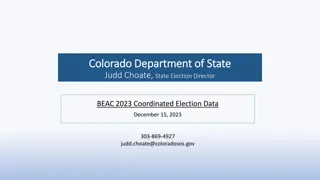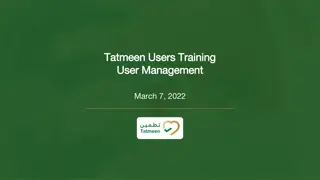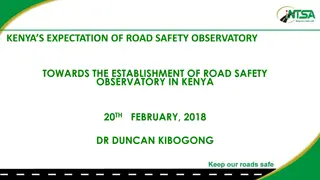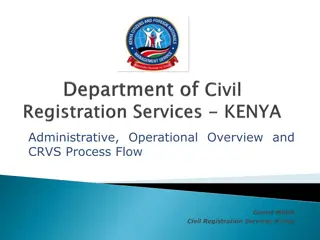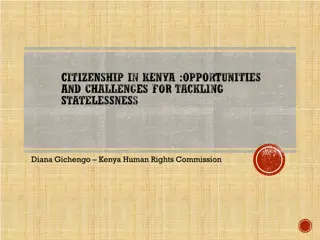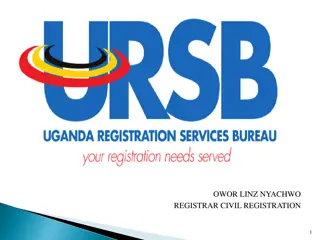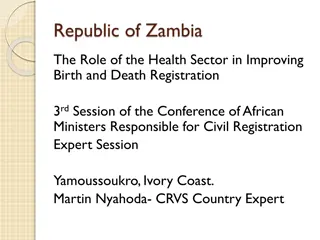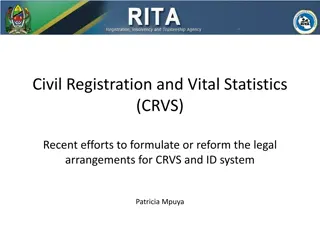Strategies for Accelerated Death Registration in Kenya: Insights from Janet Mucheru
The Civil Registration Services in Kenya faces challenges in death registration, but through lessons learned, best practices are recommended for accelerated progress. The department's core functions, purpose of civil registration, and death registration processes in Kenya are outlined, shedding light on the importance of vital statistics for legal, administrative, and planning purposes.
Download Presentation

Please find below an Image/Link to download the presentation.
The content on the website is provided AS IS for your information and personal use only. It may not be sold, licensed, or shared on other websites without obtaining consent from the author. Download presentation by click this link. If you encounter any issues during the download, it is possible that the publisher has removed the file from their server.
E N D
Presentation Transcript
Best practices and strategies for accelerated progress in death registration-Kenya Experience By: Janet Mucheru, MBS,MKIM Registrar General Civil Registration Services Kenya 1
Outline Background Death Registration in Kenya Challenges Lessons learned Recommended Best Practices 2
Background The Civil Registration Services (CRS) Department in Kenya is under the Ministry of Interior & Coordination of National Government. Mandated to register births and deaths occurring in Kenya and of Kenyans occurring abroad The department derives its mandate from: The Births and Deaths Registration Act CAP 149 The legitimacy Act Cap 145 Other related statutes, eg, the Children's Act The Constitution of Kenya 2010 Chapter 3 on Citizenship, Article 53 (1) on the rights of a child Core Functions Registration of all Births & Deaths occurring in Kenya and of Kenya Citizens occurring abroad Custody, Security and Preservation of Births and Deaths records created through registration Analysis and dissemination of Vital Statistics from registered events. Issuance of Births and Deaths Certificates 3
Purpose of Civil Registration Its also a reliable source of vital statistics (VS) which are essential for: Civil Registration is carried out primarily for identity documents for both legal and administrative purposes. creating legal i. understanding of population growth dynamics. ii. planning and implementing effective social and economic programmes. NB: Marriages are under the Attorney General s office. 4
Death Registration In Kenya registration of deaths is done on an agency basis. Health Facilities Health personnel register death events using D1 forms Community Assistant Chiefs register events using D2 forms 5
KNBS IPRS/NPR MoH Dissemination Dissemination of official Statistics Archival & CRS SUBCOUNTY CIVIL REGISTRATION OFFICE Registration of Event Issuance of Certificate Archival at District Registry Compilation of Vital Statistics Forward duplicate record to CRS (HQ) Registration & Certification Village Elder Notification Notificationof Death by Hospital Notification of Death by Assistant Chief Notification of Birth by Health Facility Notification of Birth by Assistant Chief Family Member Village Elder CHW CHW Family Member
REGISTERED DEATHS 2017-2021 Year REGISTEREDCOVERAGE % 2017 190,877 41.2 2018 192,019 40.5 2019 191,495 39.1 2020 185,385 37 2021 231,944 55.4 Death registration coverage has been on a downward trend from 41.2% in 2017 to 37% in 2020 and rose to 55.4 percent in 2021. 7
Key CRVS Milestones for the last 5 Years Development and roll out of a web-based application; Civil Registration and Vital Statics System (CRVSS) in 8 Counties. Digitization Civil Registration and Vital Statistics manual records envisioned to full automation. of 46m Use of online platform for birth and death application in Nairobi. Introduced a one day service. Development of birth and death registration SOPs and policies. Review of the current birth and death registration tools. Trained Registration Agents on data collection. Review of CRVS business process. Close collaboration Health Sector and National Statistics Office. Implementation of Rapid Mortality Surveillance in six counties. Formation of a National Technical Working group(CRVS TWG). Reviewed Strategic Plan 2018-2023. 8
Key Challenges Manual and paper-based CRS business processes. Low registration coverage with regional differentials. Data quality issues especially with Cause of deaths. Inadequate resources; human and financial. Social barriers: Cultural, religious and community values. Low demand and appreciation of the value of vital statistics. Inadequate ICT network coverage countrywide to enable the use of a computerized system across the entire country. Inadequate capacity for certification of causes of deaths. 9
Recommended Best Practices Full end-to-end automation of civil registration services. Generation of regular Vital Statistics report (i.e. Annual). Lobby for Increase resources (HR & Funding). Strong collaboration with health sector. Improving death notification and cause of death certification in health facilities. 1. 2. 3. 4. 5. 6. 7. Improve death notification and their probable causes at community level. Advocacy and awareness campaigns for Civil Registration. 8. 9. High Political goodwill. Conducting mobile registration in marginalized and hard to reach areas. 10. Use of short message alerts for appointments with clients to collect their certificates. 11. Conducting hospital audits and monitoring across the country. 10






